April 2010
Watch for the Dancing Pheasants
Dancing pheasants? Whaaat? Well, just you wait!
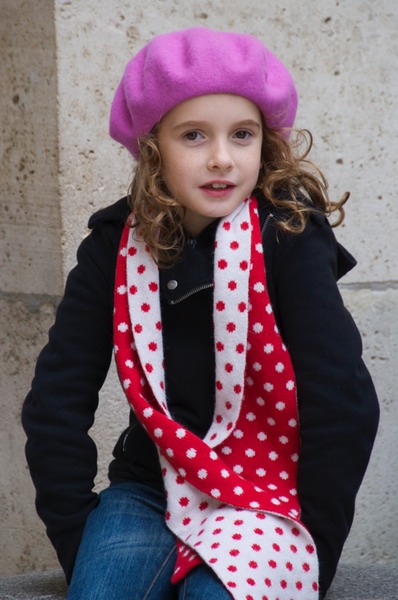
One last piece of Paris: The day before our departure for Belgium we made one more trip into La Cité as we’d been unable to get to the Musée d’Orsay before now. I have to say the Musée d’Orsay was just about the best of the best. It is set in a ca. 1900 former train station and hotel, and the building is incredible. We were not allowed to take pictures, a very disappointing situation, so we have no way of sharing the visual experience with you. But the high ceilings, incredible light and open space all provided a setting we saw nowhere else in Paris. The museum starts where the Louvre leaves off, history-wise, and the Van Gogh and Gaugain paintings are featured. But there is so much more, including a large area of Art Nouveau furnishings that left us in awe. Do not miss this museum when you are in Paris. We had to stand in line for 1-1/2 hours to get in, grumbling all the way, but it was worth it; even Rick thought so and when he sees a line for something he generally goes in the other direction!
Then on March 31 we waved au revoir to our friends in Paris and headed for the train station, off to see the world… or at least the rest of Europe. We were ready to be off on our own.
We left from the large Gare du Nord train station, where we sat and people-watched as we waited for our train to Brugge. This very old station has been modernized, but they still use the quintessential European departure board (you remember: big wooden blocks that spin individually with each letter, so they rack up the name of a city one letter at a time – watch some old movies and you’ll know what we mean). Our waiting area was near the tracks, outside, and rather chilly; we were glad we had several layers of clothes; we ended up wearing most of them, and drinking lots of hot tea.
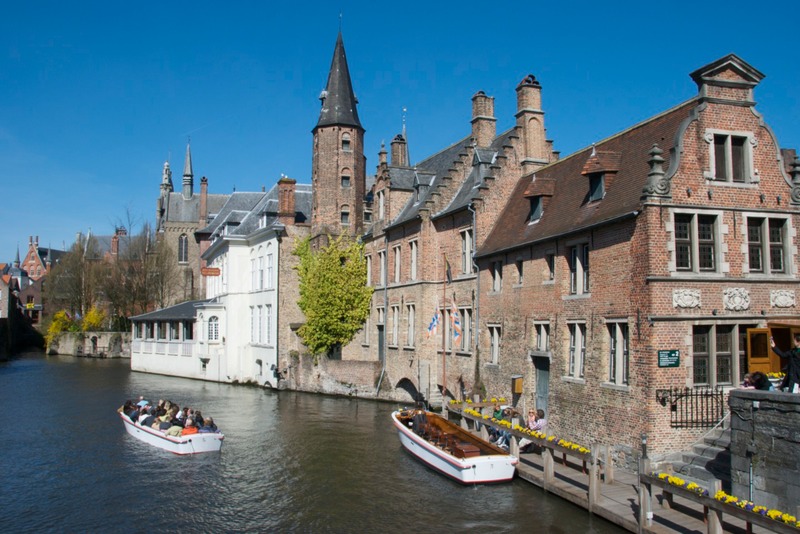
The train ride was cool; one of France’s very nice fast trains; the landscape flew past in amazing smoothness and quiet and we were in Brugge (Bruges) in a bit over 2 hours, arriving in the dark. It felt very Humphrey Bogart as we stepped down at the station. Too bad they don’t use steam engines any more.
We arrived on Wednesday evening, the same day the ship came into Zeebrugge with La Tortuga on board. Thursday morning we called the port, and found out we could pick the rig up on Friday. So we were able to have a nice day of sightseeing in Brugge before taking the local train to the coast. We stayed at the Hotel Lucca (www.hotellucca.be), absolutely charming and only a short block off the main markt (square) in the old part of Brugge. Highly recommended.
So let’s talk about Belgium. The country is culturally divided into two parts: the Flemish area to the north, and the French area further south (that’s quite approximate, by the way), so all the towns have two names. (There is also a small area in the far eastern corner that is very German.) Brugge is the Flemish word, and Bruges is the French. The country is bi-lingual. Actually it’s much more than that; we were told than most Belgians speak several languages (often including at least some English), in part because over the centuries the country was ruled or occupied by so many others: Britain, Spain, Portugal, France, Austria, Germany, to name but a few; and of course it has been Europe’s favorite battlefield forever. It has been an independent country only since 1830; we mostly remember its own colonial aspirations because of that nasty piece of work, the Belgian Congo.
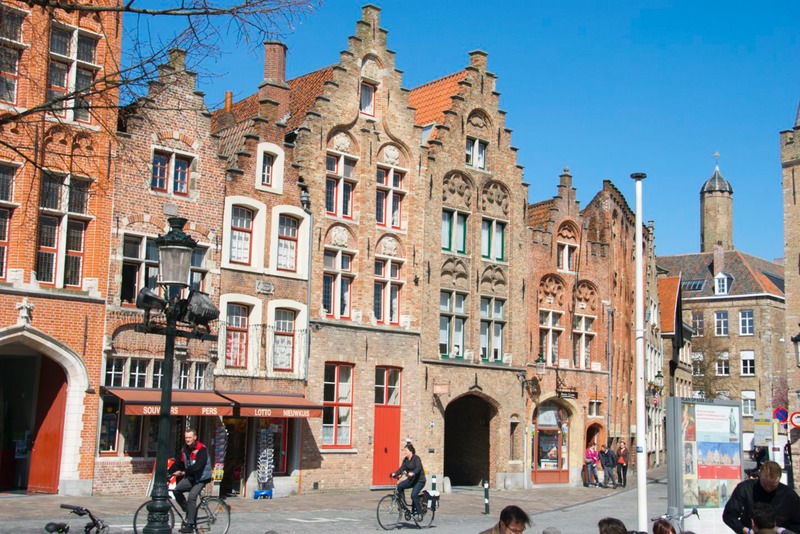
Brugge is in the northern, Flemish area. We made the mistake, early on, of trying to speak French to the fellow selling us frites (fries – the national junk food); he strongly replied in English that he was not French, did not speak French, and would not respond to us if we insisted on doing so! So…your typical national schism; all countries seem to have them, regardless of size.
More importantly, Brugge is a splendid, beautiful city, an easy city to walk, and we really enjoyed wandering around. The medieval architecture, the canals, the cathedral and other goodies: quite charming. It’s a UNESCO World Heritage site and one of the most popular attractions in Europe, not surprising. We were happy to be there in April, not July. At one point, Rick went back to the hotel for something and upon returning found Kathy completely surrounded by a group of high school age kids who’d apparently been sent out to hunt down tourists and engage them in conversation. The same thing has happened to us in Mexico and it is always a hoot: words exchanged in various languages, lots of note-taking on the part of the kids as they complete their assignment paperwork, and a really good cultural experience being had by all.
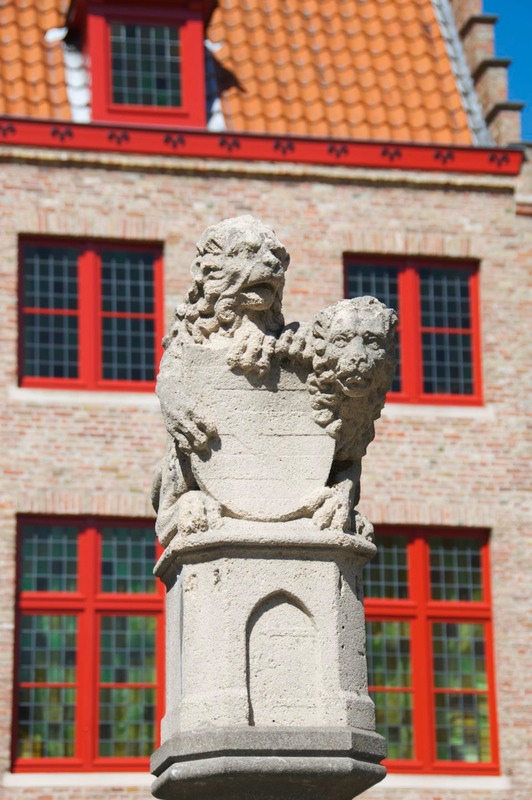
Our experience at the port, picking up La Tortuga, went very well. We continue to be very happy with using K-Line as our shipping line. Dropping the truck off in Jacksonville went smoothly, and the guys there took good care of us. We had forgotten to tuck in the rearview mirrors (your shipping cost is based on volume, and every inch counts), but we had left a message on Pete’s phone, and I noticed when the rig arrived that the ears had been properly tucked away.
The K-Line people in Zeebrugge were just as nice. We had decided the local train from Brugge stopped close enough to the port that we could walk. This was a real mistake, as Google distances can be very misleading. We highly recommend finding a taxi if you are following in our footsteps. We trudged a long way in several different directions, asking as we went; when we finally arrived at the right spot, we were pretty wiped out. And it was lunchtime by then, of course. Fortunately we had decided to leave all our gear (3 weeks’ clothes, books we’d had sent to us in Paris, cold/wet weather stuff, etc., etc.) at the hotel for pickup later in the afternoon. And I’d packed a few goodies in my backpack. So we survived. Once the office opened up again, it was only a matter of a few minutes to get paperwork straightened out, and then the very nice man drove us to another part of the port, where La Tortuga was waiting for us, untouched, pristine, and ready to hit the road. So now we are back at home again, in the coach.
We pulled out of the port, drove back into Brugge and stayed the night in a parking lot where they charged us €22.5 for the experience (over $30). We’d been told it was the most expensive Aire in Belgium; damn straight! (You’ll hear more about Aires soon.) I stayed with the coach while Rick went back to the hotel for our things. We had intended to drive straight there from the port, but missed a couple of turns coming into town, ended up at the Aire, and decided that was enough European driving for our first day, particularly as the GPS was yet to be hooked up! (By the way, the GPS has been very helpful; maneuvering through these cities and down country lanes can be very confusing, without someone to tell you what to do next.)
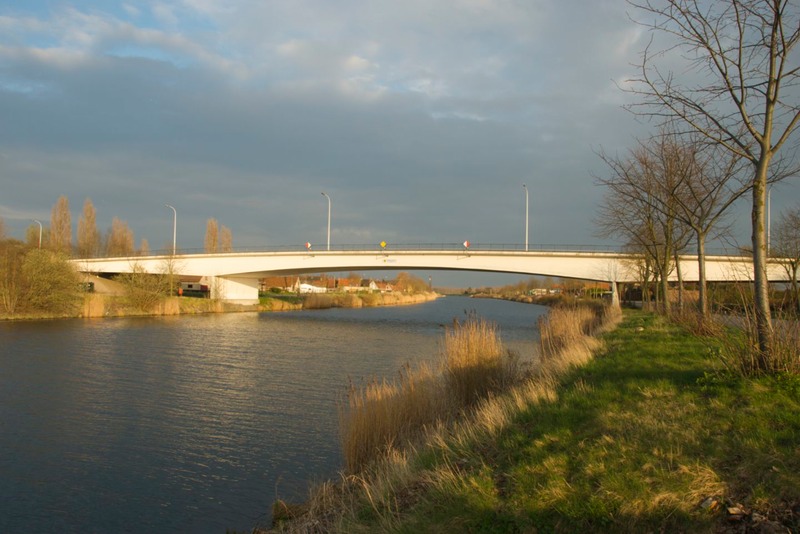
The next day (Saturday of a 3-day holiday) we left town and spent a very quiet weekend along a canal on the edge of a tiny town not too far away. Our only visitors were locals out for a walk or many of the thousands of cyclists who were in the area enjoying the biking along the canals of the Low Countries. It was great; we had plenty of time to settle in and reacquaint ourselves with home. There were barges large and small on the canal each day; we waved and they kept to business. It was fun.
We returned to Brugge for another day of sight-seeing, and then spent some time in Gent (Ghent). These are two of the best medieval cities around; they have been well maintained and are delightful. Gent is less touristy, quieter and a bit more original, but much of the center is torn up these days as they make it pedestrian-friendly, so if you’re thinking of coming, hold off as long as possible. But again, the architecture, the general scene, are all terrific. Gothic cathedrals give me chills; and these cities have good ones. While in Gent we bought some absolutely delicious, strange-looking purple chocolate-drop-shaped jelly bean kinda things. Incredible. And yes, of course we’ve been devouring the local chocolate everywhere we go. Now here’s the real question to debate: Is Chocolate a Treat or an Entitlement? In our household we seem to be evenly divided on the subject.
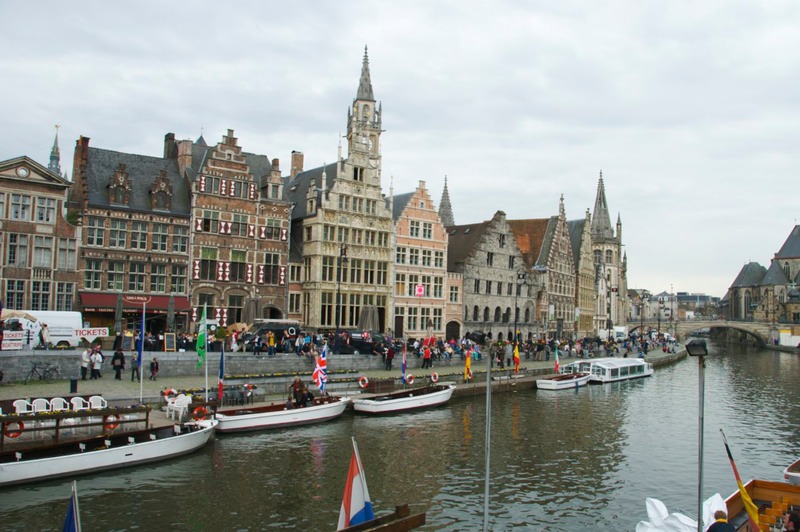
Leaving the big city, we have now wandered over almost the entire country (there is one area we have left for later – explanation is coming). During the course of our month in Belgium, we have traveled just over 1200 miles; who ever would have thought that possible! In talking to a fellow from Holland just this morning, he says he’s never even been to Belgium before! Can you believe it?
Spring has really arrived now; the flowering trees are in bloom: forsythia, tulip magnolias, pinks and whites we cannot name. The trees are leafing out, and the fields are either grassy or being plowed. The ponies are shaggy and we are seeing the most humongous, fattest cows ever. To say nothing of the sheep.
We have traveled the length and width of Belgium, and have enjoyed it all. Perhaps it’s because we are so delighted to be back on the road and seeing new areas that we have stayed so long; for whatever reason, we think Belgium is just about the best thing going.
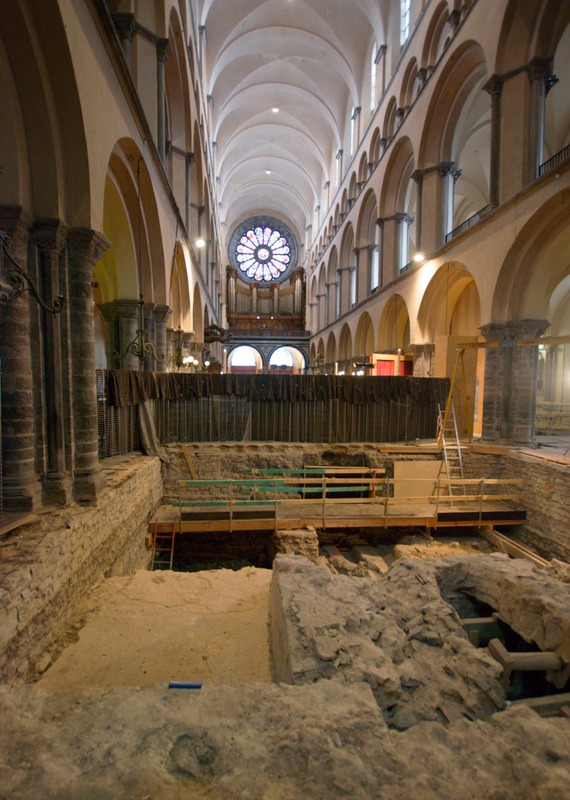
Drifting along, we’ve mostly been poking around smaller areas, only occasionally ending up in a big city. We stopped in Oudenaarde to see the cathedral; it is a terrific, charming small city; as with many other places, they had a small carnival going on, with the rides completely filling the markt in front of the cathedral and overflowing into smaller open areas around and about. This detracted from our picture-taking opportunities, but not from the atmosphere. This is the Easter season, and large chunks of kids are out of school; we run into them often, usually dressed alike, always happy to be someplace away.
Probably our favorite small-ish city was Tournai (Doornik). It’s a city to love. From the traveler’s standpoint, it has a great, free parking area near the old city center where we can overnight, complete with water and dump facilities. The Grand Place is beautiful, filled with old buildings and lots of flags and a hunkin’ cool 12th century cathedral, along with nice museums. There are relatively few tourists here. The cathedral is being renovated, in stages. It’s quiet inside, there’s a huge hole dug in the floor and scaffolding hither and yon, but you have a great feeling of it belonging to you. Hard to describe.
On a Sunday afternoon we had a chance to attend a concert in one of the other churches; also old – also being reconstructed – also neat. The concert was an orchestra from a French conservatory, playing Mahler’s 1st Symphony, with a lead-in by a very nice boys choir performing various short works. I mused on what Mahler might have thought about his 20th century work being performed in a church completed in the 12th century. Rick thought he would have been quite happy. It was a delightful afternoon.
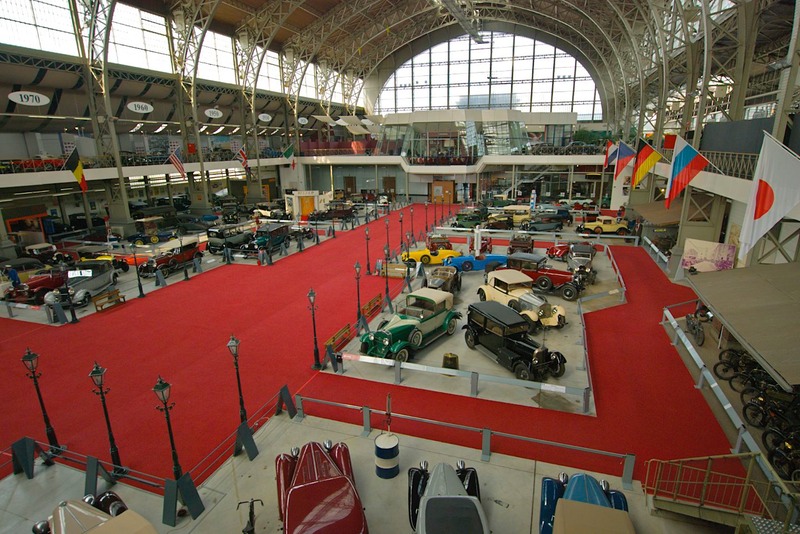
Rick has visited a couple of auto museums already, Mahymobiles in Leuze and Autoworld in Brussels. Actually they are closely related as the cars mostly come from the same local collection. Ghislain Mahy was a business man and later car dealer in Ghent and, with his two sons, traveled all over Europe and later even the U.S. picking up deals on mostly lesser known and often forgotten makes of cars, eventually totaling about 1,000. For the most part they have not been lavishly restored and many are still in original condition so it is a collection whose strength lies in its scope rather than its elegance. No concours winners to be found, just lots of varied and interesting cars. The Autoworld location is basically the National Auto Museum; it is funded by the government and has most of the more exotic cars from the Mahy family collection. But it was in the community-owned warehouse in Leuze where Rick got to chat for some time with one of the two sons; he still mans the reception desk there. His pride in his family’s accomplishment was apparent as was his passion for sharing the stories of all those cars. It was a great experience. Go to our www.motor-museums.com site to see more pictures of both collections.
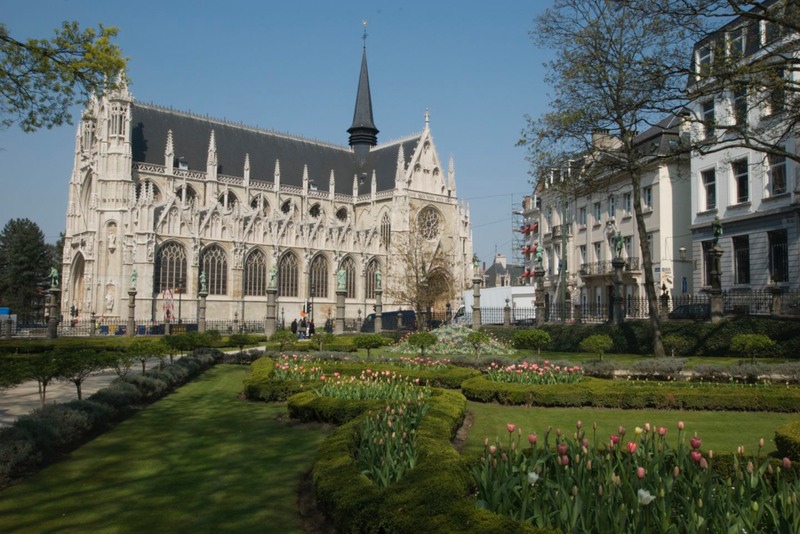
Yasha (our GPS) is having trouble pronouncing all the Flemish words, so at least for the moment we’ve switched to Emily, an English lass who seems a little better able to cope. (Actually, her full name is Emily Elizabeth; some are calling her Betsy.) The GPS is a godsend, by the way; in Latin America we only had the Garmin base map with no detailed info, but here we have it all and it has been quite useful; she doesn’t always know about detours around construction areas, but in general has amazing knowledge. Once we had to make a quick turn because the road through this tiny town was blocked; later we found out it was because there was a pick-up handball game underway and the players had closed off the street. Emily was at a loss.
From Tournai (in French Belgium) we started moving a bit further east, heading for the Ardenne area. We stopped at a couple of chateaux to poke around, and visited a really cool Romanesque church in Soignies (begun in 965). And then we got to Abbeye de Villers, an old-old-old Cistercian monastery that is in ruins. It has been left that way, rather than rebuilt, and the effect is outstanding. You can spend hours wandering the grassy grounds, peeking over parts of walls and around corners, enjoying the quiet and losing yourself in history.
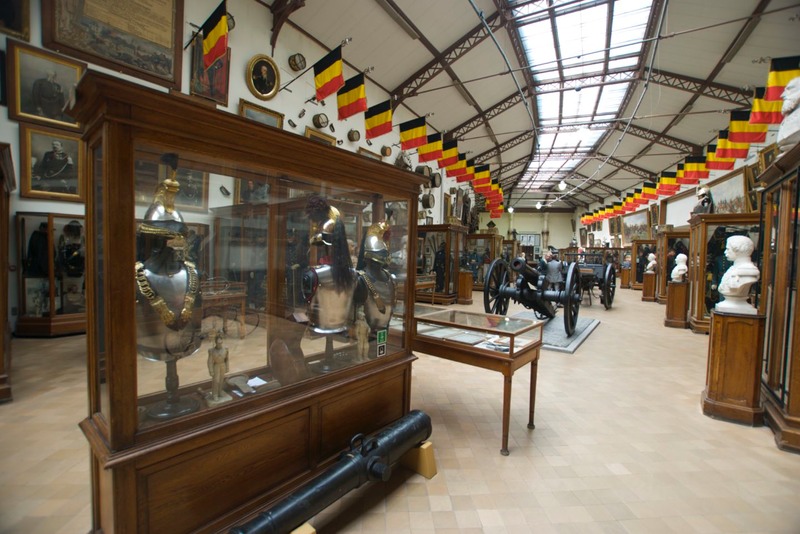
We had been discussing whether to look in at Brussels and Antwerp, large destinations. Ultimately, we figured Brussels could not be ignored, so we took a turn north from Abbeye de Villers and headed into the capital of Belgium. We whizzed right past Waterloo, of Napoleon/Wellington fame; the open fields are still there, and some monuments, but it had all the appearance of Manassas, the Civil War site outside Washington that has been inundated by development; we didn’t stop. And then Rick drove right on into Brussels. He is amazing and intrepid and has great confidence in Emily.
He successfully located the Royal Military Museum (and even a place to park), where we spent a couple of very happy hours. The museum pretty much ignores Napoleon (which we found rather intriguing); the best section was on WWI. There were tremendous numbers of displays – uniforms, small weapons, daily life information – as well as tanks, airplanes, etc. No surprise there was so much stuff, as Belgium was kind of the center of the action, and we figured the farmers were very happy to have all this junk removed from their fields so they could get back to business. The information in the museum was in Flemish and French, but we did okay. (We pretty much know the story by now.) We are looking forward to visiting some of the many WWI sites in Belgium. For the moment we have skipped the area around Ipers (Ypres), which is so famous; we’ll see that another time.
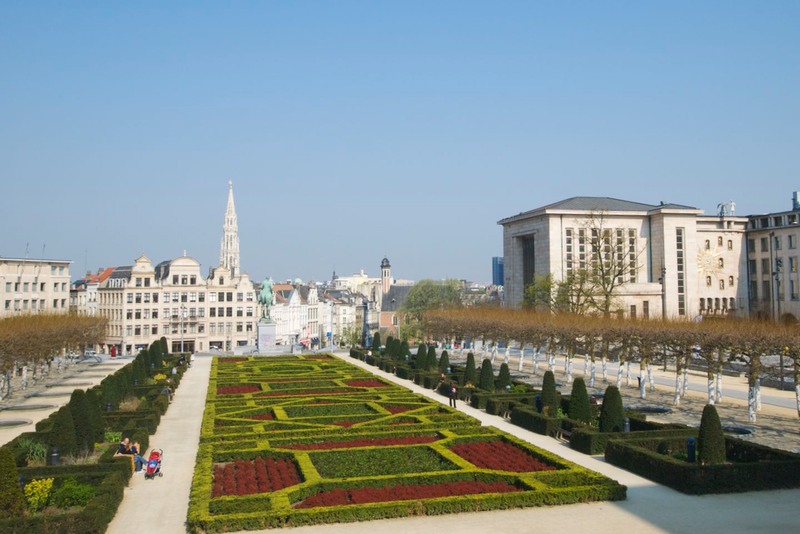
We spent a second day in Brussels as well. It is a lovely city, and has a strong international flavor. The European Union and NATO have influenced post-WWII developments; and the city is officially bi-lingual: every single sign is in both Flemish and French. Makes for really large signs… The city that tourists see is very prosperous; we saw tons of fancy cars and well dressed folks. And the parks were lovely.
This second day we took the train into the city from a smaller town to the northeast, Mechelen, where we had spent the night in an Aire (free this time; as have been almost all the Aires we have used since we left Brugge). By the way, Aires are basically community parking areas for motorhome travelers. Some have services, some don’t, some charge you to stay there, most don’t, etc. They are to be found in much of Europe and we love them.
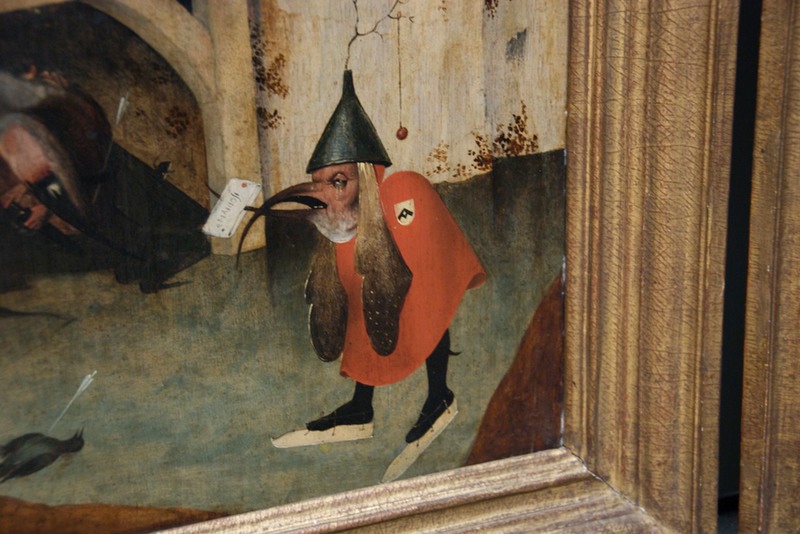
The train ride was slick; the train station (Central) is right where all the museums/cathedral/etc. are. Piece of cake. Our primary goal was the Beaux Arts Museum, touted as the best in Belgium. Well, yes, maybe. It’s a stunning building, but parts were closed and all the best of the modern stuff has been moved to the new Magritte Museum. And… just how much early Flemish art do you care about? I graduated in art history, and have an acquaintance with all these guys, and enjoyed seeing lots of “ biggies” in the flesh, so to speak; but Rick moved along pretty quickly. I was able to introduce him to three fellows he really enjoyed: Peter Breughel (both Elder and Younger) and Hieronymus Bosch. These guys are lots of fun. Rick had moved right past them, with their depictions of everyday life on the one hand, and a strange version of hell on the other, because tour groups were standing in front of them. He did hear the tour guide saying not to miss the painting of the “Dancing Pheasants,” which had seemed sufficiently weird. When I took him back to the painting in question, a delightful depiction of a country dance, he looked closely but could find no birds at all, let alone dancing ones; there were some dancing people however, and it finally sunk in: “Ah, dancing peasants...” So we both found painters to enjoy. Leaving the museum we spent several hours wandering around the city center, enjoying magnificent old buildings and enjoying the terrific spring weather; there were tulips in all the parks.
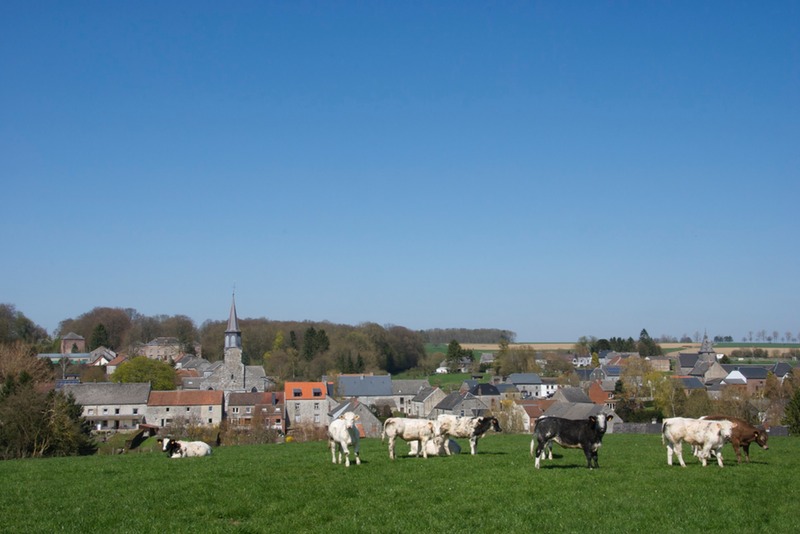
The next day we began several days’ wanderings further afield. We stared hard at Antwerp on the map (the train station is supposed to be magnificent), but couldn’t quite make ourselves tackle another big city, and headed back to the countryside further south. This is what we like best anyway. Come around a corner and there’s a castle, or a tiny town with a huge cathedral. We were able to buy early Belgian strawberries, which were quite incredible. The rich farmland was mostly fallow, but here and there farmers were planting (a couple of times it looked like seed potatoes); lots of cattle and sheep and – interestingly – burros.
We bounced around between Flemish and French areas, trying to keep up with the changes on the signs. It was a real challenge, but fun. Te Koop/À Vendre/For Sale signs. Into the Ardenne, the hills became more evident, and obviously the forest predominated. Citadels, chateaux, églises by the dozens, each more interesting and fun to see than the last. Very cool. Some of these sights were in our guidebook; others we came across just by sticking to these very tiny roads that we love.
The weekends are full of Belgians enjoying the outdoors, and we find ourselves retreating to stay out of the way. Otherwise we are wandering each day and settling in each night; happy and content. When we were planning this first stretch of our time in Europe, we hadn’t planned to stay in Belgium more than a few days; we hadn’t even bought a map of the country and were working off a puny section of a huge one. But we soon discovered that Belgium really suits us; the people are nice, the countryside is lovely, the architecture is neat, the cows are incredible, the cherry trees are in bloom… So we bought a better map and cancelled plans for the Netherlands, for now. We continued to zigzag across the country. Something would take us further north, and then further south; but we continued to slowly move in a generally southeasterly direction.
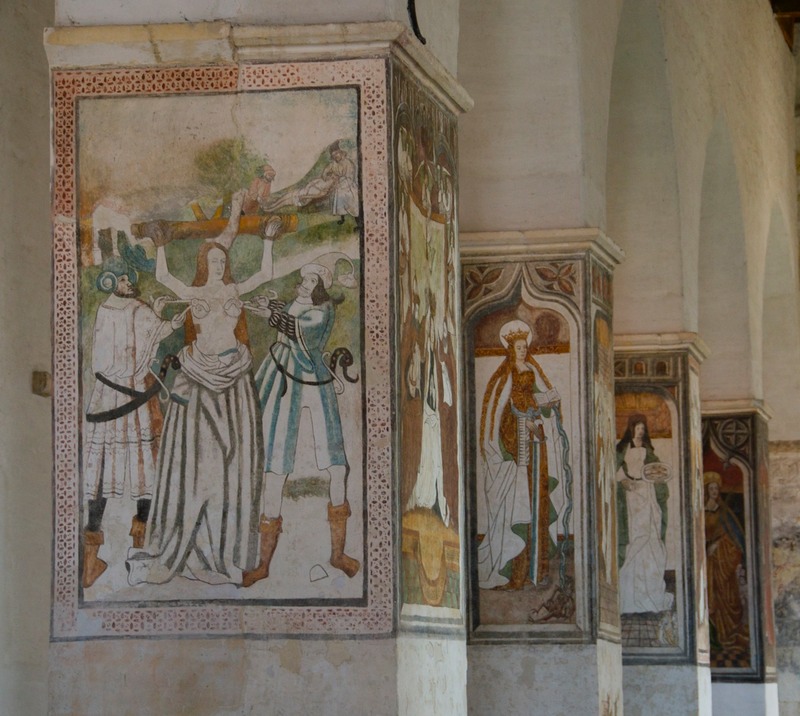
We spend our early mornings getting organized, then happily wander. One day recently, about noon we reached Sint Truiden, where we visited a Begijnhof (Beguinage) with an incredible abbey. Begijnhofs are sort of semi-convents and they date back to about the 12th century. It was seclusion for women, but they didn’t have to take vows and stuff. This abbey was very plain, but the walls had these great paintings on them. There were stone plaques in the floor marking burial spots; I saw one that was dated 1608. It was marvelous.
Then later in the afternoon we arrived in Zoutleeuw, a tiny hamlet centered on the immense St-Leonarduskerk; it’s Gothic, it’s beautiful, and it’s filled with really old relics. The oldest item in the cathedral is a crucifix dated to 1060. We spent some time talking to the caretaker, who is justifiably proud; he showed us the enormous key he uses to lock and unlock the church each day. There was a children’s choir practicing for a performance coming up soon. We tried not to distract them as we poked around, but they obviously found us more interesting than the song they were learning. We want to come live in Belgium…
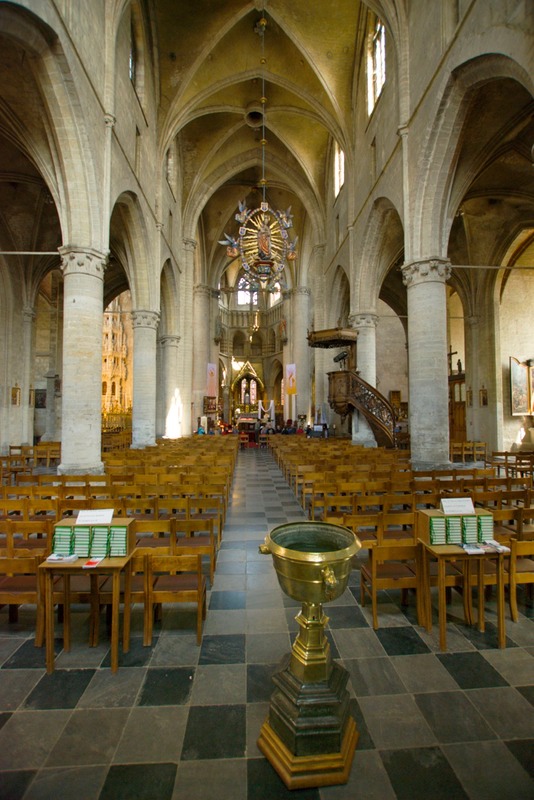
We have been particularly attracted to the Ardenne forest region. It varies from low hills interspersed with open farmland, to steeper hills and deep valleys down to significant rivers, to the High Fens area with its wild, open landscape. There’s a lot of logging in every sector; we see the lumberyards for some of it, but also the enormous woodpiles in every back yard. These are managed forests; they will have signs designating the municipality that owns the section. The entire area is very popular with locals as well as tourists; there are many resorts and lots of recreational activities. The weekends get very crowded. But lovely. We took lots of tiny roads, went through tunnels – holding our breath when they got really low – spent nights parked alongside dams, and thought about the Battle of the Bulge.
We ended up one day in the resort town of Spa, with its Casino. Now you say, Spa? What would take them to a spa area? Well, we needed a really good internet connection; McDonalds has been our source all this time and they just weren’t cutting it. We figured a resort area might be able to help us out, which they did. Problem solved, we wandered this nice old town. Reminded us of Hot Springs, Arkansas. Did you know this is the original Spa place? All the others have taken their name from here. Also it’s the very first casino; opened in 1763 under the auspices of the Bishop of Liége; what do you think of that?
By the way, Spa also has other attractions besides the restorative waters and the casino: they have a Laundry Museum. Unfortunately, it was closed when we came through; otherwise I had determined that I really had to visit; Rick was less enthusiastic, but will take me wherever I want to go, regardless how silly. (Signs told us that the Tour de France will come through here in July, too. A happening place.)
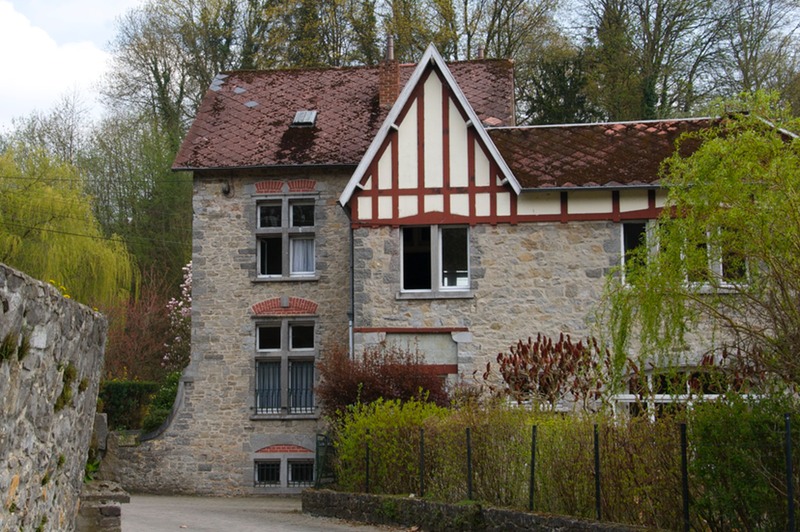
The architecture in Belgium has just overwhelmed us. Cathedrals that dominate these tiny towns, with ancient choir stalls and onion-shaped towers dating from medieval times – a dime a dozen. Ruined abbeys and castles and fortresses around every corner. I know, I’m repeating myself; you have to come and see for yourself.
Our favorite village was Hastière-par-Delà, along the Meuse River a little below Dinant. Tiny, immaculate, with this cool, really old church (the Église Notre-Dame, dating from 1030); we want to move there. These villages are simply everywhere; you look at the GPS, and there will be 20 or more within a 4-5 mile radius. Often, as you are leaving one, the steeple and clustered stone houses of the next are easily visible.
Rick had been looking forward to visiting Stavelot, to see the location of a grand old racetrack that is still very active. The town also has the remains of an important abbey that goes back over 1000 years, and a beautiful museum that details the early life of the monastery and places it in the history of the area and the Catholic church. Not being overly interested in the subject, we were a bit skeptical, but it is an incredible presentation; made you interested, and we learned a lot. A great stop.
April 27 was our wedding anniversary. We expected a quiet day, but suddenly, going down the road, we heard a loud clunk followed later by odd creaking noises. Pull over, check it out, Rick announces that we have a broken wheel. Damn! Well, we do have an extra one; it’s in Texas. So a phone call later, our buddy is sending it to us, at the home of some people we know who live outside Stuttgart; we are going to be visiting them in May. Pop on the spare and life goes on!
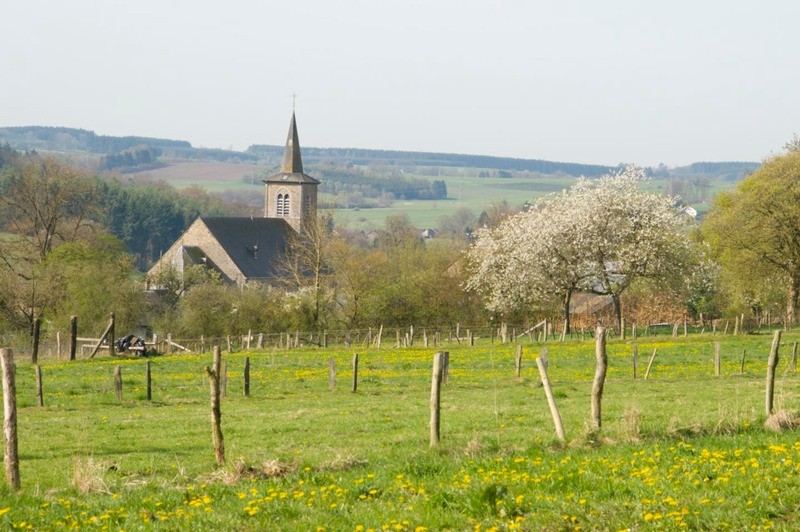
Other than emergencies, we have relatively little connection with the “real” world. We got a message from home asking if the volcano erupting in Iceland was giving us any trouble. Huh? Volcano? So we got some internet, and checked it out. The answer is no, we hadn’t even noticed; the cloud passed to the north of us as it moved eastwards. So we are trying to check the news from time to time. But, friends, we are relying on you to let us know if something important happens; we’ll probably miss it otherwise!
By the way, we have been using McDonalds almost exclusively for wi-fi; they have free, decent coverage in all their shops, they are plentiful, and Emily knows where they are! Other than that, wifi is not as available as in other areas, and unlike Latin America, there are very few – like almost no – internet access points like cyber cafes. We found a really nice restaurant in Bastogne with a wifi sign and that was a good spot, but no way to find it except to just happen to pass by. Also unlike other areas, like rural Canada for one, none of the many Tourist Information places have wifi. We’d been told all this was true so we’re not surprised.
So we have stayed and stayed. A few days have turned into a month. Our last major visit in Belgium has been to Bastogne, in the heart of the Ardenne and the focus of the Battle of the Bulge, an important WWII battle in December 1944. There is a very good museum here, a bit funky but very earnest, along with a large monument to the 101st Airborne. Belgium really is grateful to us for fighting on their behalf, and not afraid to show it. Aside from the museum/monument, there are several other sites in the area that have monuments, plaques, cemeteries, flags, etc. We wandered at will, enjoying the day.
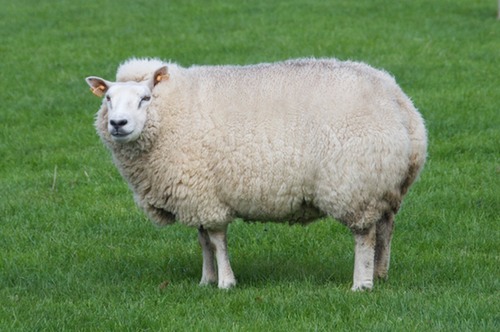
But it’s time to move on. Leaving Belgium we will cross into Luxembourg. We are very much looking forward to that country; everyone says we will love it. It’s only about 75 km long and 50 km wide, so a few days should let us see everything we are interested in – at least that’s the plan!
Keep on dancin’
Rick and Kathy and La Tortuga, together again.
Click here to view more pictures from Belgium